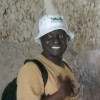This blog is written by Dr Elinaza Mjema, Lecturer in East African Coast Archaeology at the University of Dar Es Salaam (UDSM). Here he gives details on another branch of the CONCH project which took place in the summer of 2018, wherein students from UDSM and secondary and primary school students collaborated at excavations near Pangani bay.
There is also an end note by student Verynice Mtaki Nyaonge, a second year student in BA Archaeology & Geography at the Department of Archaeology and Heritage Studies, UDSM. She details her experiences working with the primary schools in Swahili.
***********************
ELINAZA MJEMA-UDSM
One of the intentions for the CONCH project is to ensure that university students and primary and secondary school pupils in Tanzania are familiarised with the types and importance of the built heritage that surround them, specifically those found in Pangani and at Kilwa on the Tanzanian coast. Students who undertake a BA degree in Archaeology and Heritage Studies at the University of Dar es Salaam (UDSM) are required to spend a total of 112 days in the field before graduation. These field schools help them to have longer and direct interaction with the cultural heritage resources found in different parts of the country. The benefits and knowledge that UDSM students acquire during field schools typically are not shared with their juniors in primary or secondary schools, despite the fact that the UDSM teams may use a school for their base camp when out doing fieldwork, and as temporary storerooms for the archaeological materials they recover. Not involving these school pupils by informing them about the fieldwork going on nearby hinders efforts to create young stakeholders who as they grow up, can directly intervene to protect, conserve and realize benefits of cultural heritage.


To help make sure that the CONCH project benefits students at different levels, during archaeological field training of UDSM students in August 2018 around Pangani Bay (focusing on Kikokwe Fort, see Figs 1 & 2) we welcomed a field visit by students from Kikokwe primary school nearby. The primary students spent the entire day with the UDSM field team walking around the site, listening to and helping team members, and also telling the UDSM university students what they knew about the area.
When the primary students and their teachers arrived, the UDSM students provided them with a brief orientation about the history of the Fort and the aims of the project (Figure 3). They were told that the Fort was built by German forces and used as a defensive structure during World War I from 1914 to 1916. The UDSM students also spoke about the importance of preserving Pangani’s built heritage for the benefits of history and tourism. After which the primary students were encouraged to ask questions and the UDSM students also directed some questions to them.
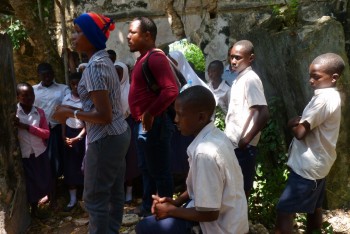

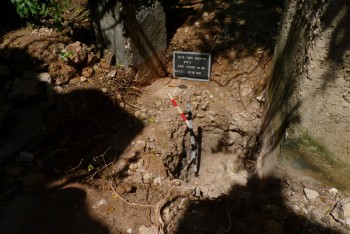
The UDSM students also explained how they documented site and explained why we had decided excavated outside (Figure 4) and inside (Figure 5) the Fort. They pointed out that these excavations aimed to reveal something about the communities that lived in the area before the Fort was built.
The primary students were shown archaeological artefacts and soil profiles that preliminarily indicated that before the Fort was built the area was inhabited by late Zanjian (Tana) communities (AD 950- 1250) who made late TIW pottery. The area was then abandoned until AD 1700, after which it was continuously occupied until the Fort was built.
The direct interaction and communication between the UDSM archaeology students and their juniors at the fieldwork site (Figures 3 & 6) has hopefully brought benefits to them both. We hope the visit has encouraged the primary students to love archaeology and heritage, and even think of these as promising disciplines for future study. The act of getting involved with the archaeology and heritage of Fort Kikokwe, albeit for a single day, hopefully will also inspire these primary students to be future protectors and conservators of cultural heritage around Pangani Bay.
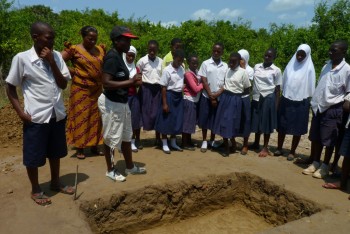
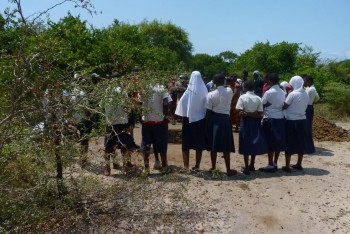
Naitwa VERYNICE MTAKI NYAONGE ni mwanafunzi kutoka Chuo Kikuu cha DAR-ES-SALAAM.
Ninasomea masomo ya sanaa ya malikale na jiografia katika mwaka wa kwanza. Mimi na wenzangu tulifanikiwa kwenda kwenye mafunzo kwa vitendo katika,mkoa wa Tanga, wilaya ya Pangani. Nikiwa katika mafunzo kwa vitendo mimi na wenzangu tuliweza kufanya uchimbaji katika eneo lilojulikana kama Kikokwe. Tulifanya utafiti katika eneo kwani kulikuwa na jengo la kihistoria. Jengo hili lilikuwa ni ngome ya Wajerumani. Pia eneo la Kikokwe ndilo eneo la kwanza kupandwa mbegu za katani katika Afrika.
Katika kufanya mafunzo yetu kwa vitendo tulihifadhi vifaa vyetu katika shule iliyokuwa jirani na eneo hilo iliyojulikana kama shule ya msingi Kikokwe. Utendaji kazi wetu katika eneo la Kikokwe kwa muda mrefu ulileta maswali mengi kwa jamii iliyotuzunguka katika eneo la Kikokwe kwa kutaka kujua ni nini kinachofanyika katika mazingira yale ni kwa nini. Hivyo basi hata wanafunzi wa shule ya msingi Kikokwe nao hawakuwa na uelewa juu ya kile tulichokuwa tunakifanya katika mazingira yale. Kutokana na ukosefu wa uelewa wa malikale katika jamii ile tuliamua kuwaita wanafunzi wa darasa la saba kutoka shule ya msingi kuweza kuwaeleza ni nini tulichokuwa tunakifanya, kwa nini na ni kwa namna gani tuliweza kufanya.
Nilikuwa mmoja wa wanafunzi walioweza kutoa ufafanuzi juu ya malikale na juu ya Uchimbuzi katika eneo la Kikokwe. Wanafunzi wa shule ya msingi Kikokwe walikuwa na maswali mengi juu ya kile tulichokuwa tunakifanya na hivyo kutokana na uelewa niliokuwa nimeupata niliweza kuwaelewesha sababu na malengo ya kufanya uchimbaji katika eneo lile la Kikokwe, njia na namna tulivyofanya kufanikisha zoezi zima la uchimbaji. Kupitia maswali waliokuwa wanauliza wale wanafunzi yaliweza kunipa ufahamu na kutambua kuwa jamii kubwa katika lile eneo hawana uelewa na hawajui umuhimu wa Akiolojia. Pia nilitambua umuhimu wa kuwaelimisha wanafunzi kama wale kuhusiana na malikale ili kuweza kufanikisha uhifadhi wa mazingira ya kihistoria kama yale.
Mbali na wanafunzi wale kuuliza maswali walimu walioongozana nao pia hawakusita kuuliza sababu zilizotufanya kwenda eneo la Kikokwe na ni nini umuhimu wa malikale. Pia waliuliza ni kwa jinsi gani tuliweza kuchimba na vifaa gani tulivyovitumia katika suala zima la uchimbaji na kwa nini tulitumia hivyo vifaa. Yale maswali ya walimu wao pia yalinifanya nitambue umuhimu wa kutoa elimu ya Akiolojia katika maeneo tunayokuwa tunaenda kufanyia mafunzo kwa vitendo ili kuelimisha jamii inayozunguka maeneo hayo.


